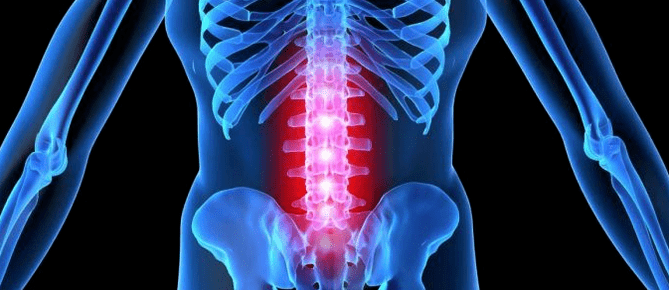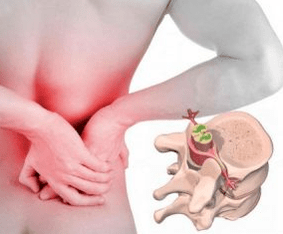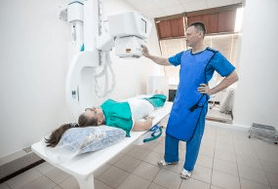A degenerative disease in which the vertebrae body is destroyed and the intervertebral disc is deformed is called osteochondrosis of the spine.The causes of such pathology can be varied, and in order to be treated correctly, it is important to determine what exactly affected the progression of deformation in the lower back.If a person is concerned about the characteristic symptoms of osteochondrosis, you should contact the hospital immediately.
At 1 stage, it will be possible to cure the problem with special medicines and exercises, but the conservative method does not always help at 2-3 degrees, so you need to turn to a surgical method of treatment.

Main reasons
One -sided left or right lumbar osteochondrosis is a disease of a degenerative nature in which the intervertebral disc is destroyed, a fibrous ring breaks down and a person has a hernia that causes acute pain and impaired muscle system function.The following factors can provoke osteochondrosis at the lower back:
- increased physical activity in the lower spine;
- Incorrect body location when walking, sit;
- Sitting, sedentary lifestyle;
- impaired behavior;
- injuries, fractures or bruise that cause degenerative consequences on the back;
- Congenital pathologies of the structure of the musculoskeletal system, in which the signs of deformation can already be seen in the child;
- Obesity;
- Stress, malnutrition.
Stages and symptoms
Signs of lumbar osteochondrosis develop as the disease progresses, and the greater the phase, the stronger the symptoms are manifested.There are 4 degrees in total:
- At 1 stage, the fibrous ring is damaged, the pain is not pronounced and often worried after prolonged walking.Pain is manifested by 2 species - lumbalgia, when the symptoms are constantly disturbing, and lumbago, in which signs suddenly occur.
- Pop 2 degrees osteochondrosis is characterized by a major destruction of the fibrous ring and disk dystrophy.Such a violation leads to a decrease in space between the vertebrae and the squeezing of the nerve fibers.Progressive phase 2 is associated with severe back pain, in the morning there is a hardness that does not pass for a long time.
- In 3 stages, the fibrous ring in the affected area is completely destroyed, which is why a hernia is formed, which compresses vessels and roots of the spinal nerves.The back hurts constantly, the symptoms do not withdraw after rest and reduce the loads, you feel tingling and severely in the legs.In the third degree, the dystrophy of muscle fibers occurs, as a result of which the patient's movements are limited.
- In 4 stages, the spine is completely deformed, a person worries about acute pain, due to which motor activity is completely limited.Due to impaired intrigue and blood supply, swelling in the foot appears, bone formations grow between the vertebrae.To the last extent, the risk of disability is high.
Lumbar back osteochondrosis syndromes
Lumbar osteochondrosis is manifested by the following syndromes:
- Pain is the main symptom that characterizes degenerative-district disorders in the spine.As the pathology progresses, the symptoms become pronounced, the attacks can last several days, adversely affecting human health.
- Koreshka.Due to the thinning of the damaged disk body, the height of the intervertebral space decreases, due to which the vertebrae becomes unstable, irritating and squeezing nerve endings.A person is concerned about acute pain, nerve inflammation, damaged blood supply.The muscle frame is atrophied, due to which the functionality of the lower extremities is concerned.
- Ischemic.Progressive osteochondrosis of the lumbar region leads to the fact that blood vessels and arteries piercing the spine begin to compress.This disrupts blood supply and nourishment of internal organs and tissue, and also causes acute pain in the inner thighs, in the perineum.If the problem is not eliminated in a timely manner, paralysis or paresis is possible.
- Vertebral.With the progression of pain, ischemic and radical syndromes, the patient's spine gradually deformed, which significantly affects the condition and well -being.The muscles become weak, the walking changes, the person tries to distribute the load on the back so that when you move to prove a minimum discomfort.Such violations affect the work of the internal organs, while the intervertebral discs continue to deform and are even more damaged.

If the treatment of osteochondrosis of the lumbar region was inappropriate or performed in a timely manner, hazardous complications may develop.In women, when vertebrae at the L1 - S1 level, complications can occur during pregnancy, especially in the last periods, when the load on the spinal column is maximum.In men, degenerative processes in the middle region often cause problems with power.Premature treatment threatens reactive spondylosis, as well as a high probability of development of knee osteoarthrosis, hip joint.Other consequences also manifest:
- compression ischemia-vascular;
- extension;
- spondylarthrosis;
- Pareza.
Troubleshooting
In order for the physician to choose effective treatment methods, he must create an accurate diagnosis.The diagnosis begins in the office of a neuropathologist, who performs an initial examination, palpate the affected area, evaluates the nature of the changes in the spine.In the acute period, the patient can hardly move and perform any complex manipulation.For a more detailed study of the spinal column, instrumental diagnosis is described, which includes:
- X -Ray.It is performed in 3 projections, the pictures show the degree of progress of the pathology, the size of the intervertebral cleft, the salty deposits, the structure of the vertebrae.
- Ct or MRI.Give a more detailed view of the spinal cord and discs, indicate soft tissue violations, which cannot be considered during an X -Ray examination.
How to treat the problem?
Medication
The disease is characterized by the progression of a symptom of pain that not all medicines can cope with.In the early stages to stop the signs, you can get the sedative.And the problem is also treated using ointments and special gels.In advanced cases, such medicines will be ineffective, so the doctor will prescribe injections, thanks to that relief and first aid will be on time.

Non -inflammatory drugs non -inflammatory do not help relieve swelling and inflammation, so that nerve fibers and blood vessels cease compression, and the symptoms of pain will decrease.The group includes funds:
- Sedatives of sedatives.With the progress of the acute period, when pain is severely expressed, the drugs of this group are prescribed.Since they have side effects, do not buy funds at your discretion.A safe and effective drug should be prescribed by a doctor.
- Musorelaxants.Relieve muscle cramps, due to which pain and discomfort reduce.
- Glucocorticosteroids.Eliminate inflammation, positively affect the nervous system, improve the patient's condition in a short time.
exercise
If osteochondrosis L5 - S1 is diagnosed or discs at the L3 - S1 level are affected, therapeutic exercises are required.When performing the training complex, it is important to increase the load gradually so that there is no discomfort and pain.It is recommended to do the following exercises with osteochondrosis:
- In the standing position, make the curves to the right and left, bending back and forth.
- Standing on all four sides, bend and line up.
- Lying on the floor, even raising the legs, without tearing the lower back from the floor.
- In the position of lying with the left hand, reach the limb, which is on the right and, conversely.
Massage and physiotherapy
Chronic osteochondrosis at the remition stage is successfully treated using massage procedures performed by a manual therapist.Massage will help normalize blood circulation in the affected area, create food.Physiotherapeutic procedures have a similar effect:
- electrophoresis;
- Magnetot therapy;
- Laser therapy;
- UHF.
If patients with left or right arm osteochondrosis would not help conservative methods, then you cannot do without surgical treatment.Microdiskics are often used, in which the seized hernia is removed using microsurgical tools.Psidium procedure Minim, the next day after surgery, the patient may begin to move.
PREVENTION
Since adults and children suffer from osteochondrosis, it is also important to monitor the spine at a young age, to control the behavior, pay attention to what bending or movement looks like.If there is a doubt about deformation, you should see a doctor.The sooner the disease is diagnosed, the easier it will be to fight it later.





































